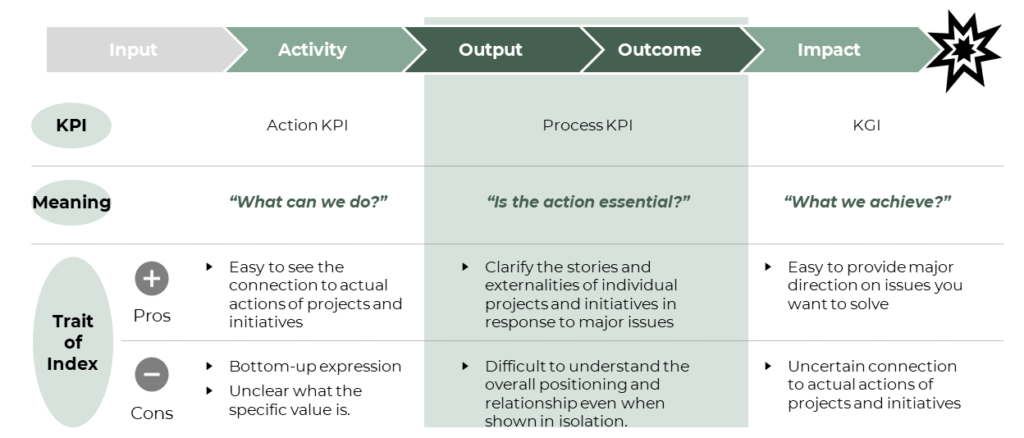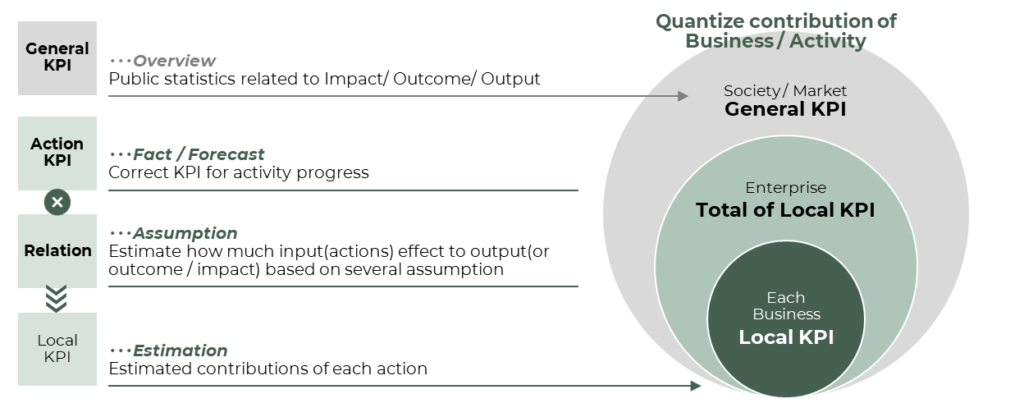Considerations for KPI
Once your Impact Model is in place, and the relationships between individual elements, as well as the specific pathways for creating impact, become relatively clear, it’s time to establish Key Performance Indicators (KPIs) for quantitatively measuring the progress and magnitude of the impact you’re creating. When setting KPIs, it’s relatively straightforward to define specific Action KPIs and final Key Goal Indicators (KGIs). However, the establishment of Intermediate KPIs is of paramount importance within the context of the Impact Model.

KPI Selection for Performance Management and Disclosure
In many cases, when the actual results (impact) of initiatives are to be determined and disclosed to the public, indicators that are closer to the expected results (impact) tend to be selected.
In particular, for those for which public data is available, it is possible to clarify the company’s contribution, and therefore, it is possible to measure indicators closer to the actual results (impact) on a top-down basis (i.e., to compare cases in which the company’s initiatives were implemented with those in which they were not).
On the other hand, when the effects to be generated have a long time axis, Action KPIs and Process KPIs are important as year-based KPIs, since from a practical standpoint there is a certain degree of need to show the difference from the previous year and specific progress.
KPI Selection for Target Planning
In cases where targets and planned values for creating results (impact) from future efforts are determined, there is a tendency to estimate impact in a bottom-up manner based on KPIs rather than actions.
This is to ensure consistency in how much impact should be assumed in planning and how much activity targets should be assumed when specific impact delivery targets are assumed.
In practice, although the action KPIs are clear, securing the information assumptions in the estimation logic (evidence on the level of utility per unit for a certain action) is often a problem, so the scope of target setting can be expanded according to such data availability.
Perspective of KPI Selection
The following perspectives should be identified for effective KPI setting as described above.
It is assumed in most cases that there is probably no indicator or information that satisfies all requirements, but it is important to select the perspective to focus on according to the objectives.
In addition, in ongoing impact management, it is also important to appropriately recognize that such assumptions themselves have changed, and in some cases, to organize and disclose such changes as information.
Validity / Adaptability
Do the selected metrics accurately represent the impact being evaluated? Pay special attention to the following:
- Stock vs. Flow (Is it measured cumulatively or annually?)
- Units of measurement (Per capita? National level? Especially in cases of scale-down equilibrium)
- Use of ratios (Generally discouraged; if used, components should be separate KPIs)
Clarity / Generality
Is the selected metric easily understood and intuitive for most people to grasp and comprehend the impact?
Is it general information that has been proven in the disclosure of the company, other companies, etc.?
Connectivity
Can the selected metrics be defined in relation to other metrics without difficulty, and can they be converted and integrated?
Public Availability / Fairness
Is the selected metric constructed from information that is accessible to anyone?
Also, is the information itself arbitrary or biased?
Continuity
Is the selected metric based on information that is collected and maintained at regular intervals suitable for assessment?
Data / Information Freshness
Does the target indicator reflect information on the most recent situation?
Accuracy / Reliability
Is the selected metric derived from sources of information that can be trusted?
KPI Setting
The quantitative evaluation of impacts in each domain (i.e., the quantification of contributions for individual projects or initiatives) is estimated based on the KPIs at the individual project level (e.g., actual performance, budget, etc.) by assuming relationships. By standardizing units, it becomes possible to make horizontal comparisons, calculate totals for the entire company, and compare with the market as a whole. Specifically, IMPACTLAKE recommends setting three types of KPIs as follows.

General KPI
A KPI that reflects the overall societal and market trends related to a specific impact (outcome or output). It is not tied to individual companies or specific business activities but is often based on publicly available quantitative information, such as public statistics. In most cases, it’s desirable for General KPIs to meet the aforementioned KPI requirements and be comparable to Local KPIs (company-specific KPIs based on Action KPIs).
Action KPI
Contributions at the level of individual projects or activities. Action KPIs are derived from corporate disclosures and KPIs that seem appropriate for the activity. They can be based on actual performance or future forecasts. For example, it could relate to the market penetration of a substitute for medical representatives (MRs).
Since KPIs largely depend on a company’s information disclosure practices and data availability, it’s important to prioritize continuity and validity. Additionally, it might be necessary to estimate KPIs based on the situation. In some cases, a lack of disclosure is assessed as “lack of intentionality” rather than as a lack of data.
- Data that directly reflects the results achieved (e.g., product operating hours, user usage frequency).
- Data that allows for estimating the potential effects (e.g., the number of product units sold, the number of service users).
- Data that indirectly contributes to the estimate (e.g., product revenue, ARR).
- Coarser data (e.g., segment revenues to which the product belongs).
Local KPI
An indicator that shows how much individual business initiatives or undertakings are linked to significant impacts. It is calculated based on Action KPIs and expressed in the same units as General KPIs, enabling a better understanding of the extent to which specific business initiatives or activities contribute to impact.
(e.g., Equivalent Reduction in Healthcare Public Expenditure due to the Market Penetration of MR Alternative Tools)
Relation (KPI Relationships)
Relations involve calculating how changes (increases or decreases) in the quantity per unit of the input items result in changes in the output, based on various assumptions. The relation between Action KPIs and Local KPIs is Action KPI * Relation = Local KPI.
